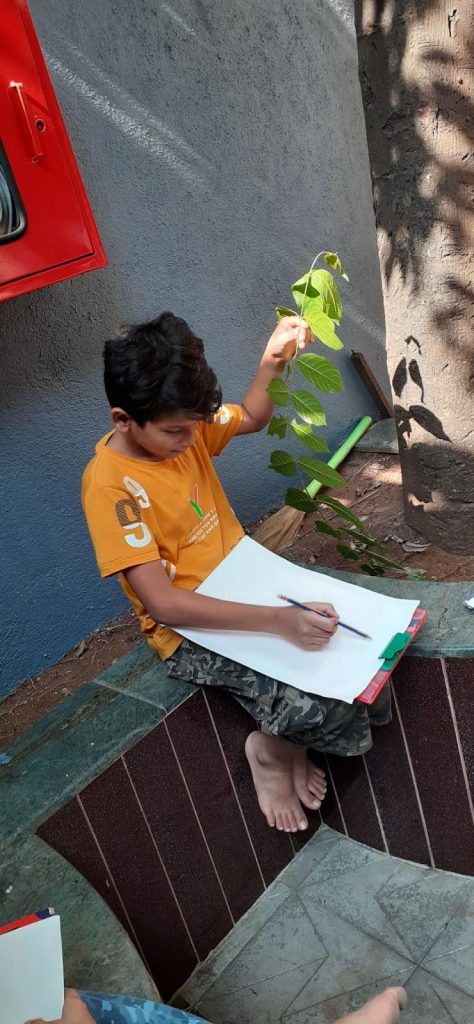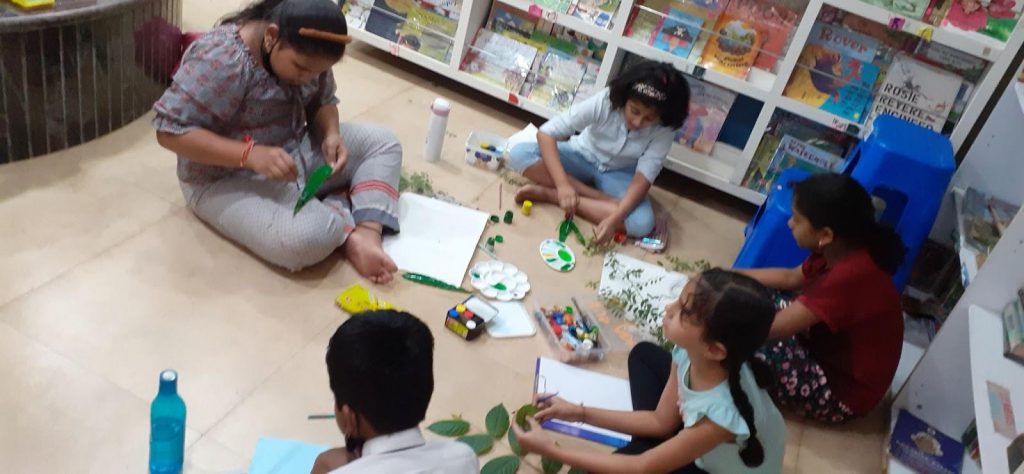May 2022
Often, art in school is limited to copying or practicing a skill. The Mehlli Gobhai workshop series enabled me to go beyond this with a group of 9-11 year olds at Sharon School, Mumbai. Looking outside helped children to peer inside. How did this happen? Read on to find out.
Sanika, the art educator from Bookworm, would meet us, a group of facilitators from different parts of India, virtually once a fortnight. During this time, we experienced what it meant to look at art, talk about it and create art ourselves. Sanika would in part model and in part guide us on how we could conduct our sessions with our participants. Sanika would also share lesson plans which helped us plan and execute the sessions with children, leaving enough space for adaptations and flexibility to work in our contexts. Our hope was to engage with The Tree Book and eventually enable each participant to create their own Tree Book.
When I took a few of Mehlli Gohbai’s abstract paintings to my children on the first day, they hesitated to accept it as art. For most, it was the first time they were looking at and responding to an artwork. Slowly, some said the paintings represented,
“Mess”
“Confusion”
“Sadness”
Some even saw objects hidden as symbols!
As we proceeded to make our own abstract paintings, there was hesitation to make the first mark on the paper. Discouraging children to use pencils and work directly with colours helped.
Sharing my art and talking about it helped children think about how they could get down to making their art work. They listened intently. They thought carefully. They were provoked to look inside. Deep personal connections were evident in what they painted.
Read more Stories from the School
Dhwani: I’ve tried to show my life through the pandemic and now…these colours show how we all suffered a lot and now brightness and happiness is coming back to our lives.
Kanishk: I’ve drawn the Ukraine – Russia war and the dots show the many lives that have been lost
Rikhav: Sometimes I wonder how our eyes see so many colours. I’ve tried to draw an eye…seeing all the colours.
In a later session children shared how they were worried and apprehensive on the first day as they didn’t think of themselves as good artists. But as the sessions went on, some things changed.
Looking at artworks with their peers led to talk and discussion which otherwise rarely finds space in the traditional classroom. O’Keefe’s Lawrence Tree, Mitchell’s Trees III and Carnegie’s Black Square generated much discussion on perspective, colours and lines.
Children look at tree paintings by O’ Keefe, Mitchell, Klimt and others
There was another thing that helped and we realized it only later. One day Bernice told us, “When Edwin Sir came and saw my tree painting and said “WOW”, I really felt happy. I felt like I could really paint well” The genuinely positive responses we as facilitators gave students as they worked, was crucial in keeping them going.
As the workshop was hosted within a library, books were an important part of each session. There were book talks, book games and book borrowing. The idea of making tree books started with a shared reading of Mehlli Gohbai’s Tree Book.
The wordless picture book and the accordion format in which Bookworm had kindly sent it to us fascinated the children.
The shared experience of reading the book triggered many entry points to create their own tree books.
Sanika’s lesson plans always thoughtfully built in a lot of scope for movement, interacting with the outside world and observing things, slowly and carefully. This slow and careful ‘looking’ gave children tools and the confidence to manifest it in their paintings in the later sessions.



Observing leaves, barks and branches in our small urban school compound led to many interesting things.
The last three sessions were held in the public garden which is a stone’s throw from our school. The experience of identifying a tree to illustrate, observing it, wondering, researching and planning the pages of the book, was a joyful and stimulating experience.
Arnav noticed mangoes overhead, a butterfly sat on Angel’s nose, Kanishk imagined the tree against the night sky, Dhwani used google lens to find out more about her tree.
The sense of freedom and responsibility this act brought was new for most and they honoured it so beautifully.
Seven tree books emerged at the end of our 5 week long workshop and each one is going to find a special place in our library collection. Each one was a story world in its own way.
The workshop culminated with a small pop-up display of all the art work that children had created, in the school compound. It was open to everyone who was visiting school that week.
As an educator, this experience reaffirmed for me that the library can be many things, but most importantly, that it can be a safe space to share, talk, disagree and create. We must hold onto this space. I am deeply grateful to Sanika and the Bookworm Team who conceptualized this workshop and held us through this process. And thank you to Mehlli Gobhai , whose art compelled us to look at our world through a fresh lens.

